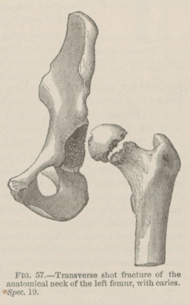Title: Christopher, T. C.
Source text: The Medical and Surgical History of the War of the Rebellion. (1861-65.), Part 3, Volume 2 (Washington, DC: Government Printing Office, 1883), 105.
Civil War Washington ID: med.d2e5302
TEI/XML: med.d2e5302.xml
CASE 245.—Private T. C. Christopher, Co. D, 18th South Carolina, aged 21 years, a robust man, was wounded at Williamsburg, Virginia, May 5, 1862, by a conoidal musket ball, which entered about two inches below and behind the left trochanter major, and passed forward, upward, and inward. He was stooping at the time he received the injury. He was made prisoner, and sent to York River, and thence on a hospital steamer to Washington, and placed in Cliffburne Hospital, May 17th. His pulse was 100, and he complained of severe pain in the hip and knee. The tissues about the hip were much swollen; the limb was everted, and shortened one and a half inches. The opening made by the bullet was very small, and discharged a thin sanious pus. There was no orifice of exit. The patient was etherized, and careful exploration of the wound revealed a fracture of the inner portion of the neck and probably of the head of the femur. It was decided that excision should be performed, and the patient was placed upon a soothing and supporting regimen preparatory to the operation. May 20th, Assistant Surgeon J. S. Billings, U. S. A., made a curvilinear incision, four inches in length, one inch behind the great trochanter, that revealed the condition of the parts. Fragments of the inner extremity of the neck were removed piecemeal. The head was then removed from the cotyloid cavity, except a small fragment which was extracted from an intermuscular space. The ball was now discovered lying in the obturator externus muscle, and extracted. Little blood was lost, and reaction took place. Water dressing was applied, and a grain of sulphate of morphia administered. Eversion of the foot was corrected by fastening the limb by straps of adhesive plaster to an upright piece of wood screwed to the foot of the bedstead, and, the latter being raised, adequate extension and counter-extension were secured. On May 21st, the patient reported a comfortable night, but now had a very irritable stomach, with frequent vomiting. His skin was cool and clammy; his pulse small and feeble at 115. He was ordered aromatic spirits of ammonia in small doses, brandy, egg-nog, and beef essence, with sinapisms to the epigastrium. On May 23d, the irritability of the stomach had subsided. The patient was weaker; stimulants and concentrated nourishment were given. On May 24th, the patient rapidly grew weaker. Capillary hæmorrhage took place from the surfaces of the incision, but was readily checked by the application of a solution of persulphate of iron. Enemata of beef essence and brandy were administered, and these articles also by the mouth. The patient sank rapidly, and died May 24th, five days after the operation. At the autopsy, twelve hours after death, the soft parts about the seat of injury were found dark in color and softened. The acetabulum was eroded. A clot of blood of three ounces was found between the peritoneum and iliacus externus muscle. The innominatum and superior portion of the femur were removed, and, together with the excised fragments, forwarded to the Army Medical Museum, and numbered 19 of the Surgical Section, having been mounted among its earliest specimens, and it is represented in the wood-cut (FIG. 57).—(Circ. 6, S. G. O., 1865, p. 62, and Circ. 2, S. G. O., 1869, pp. 35, 135.)
